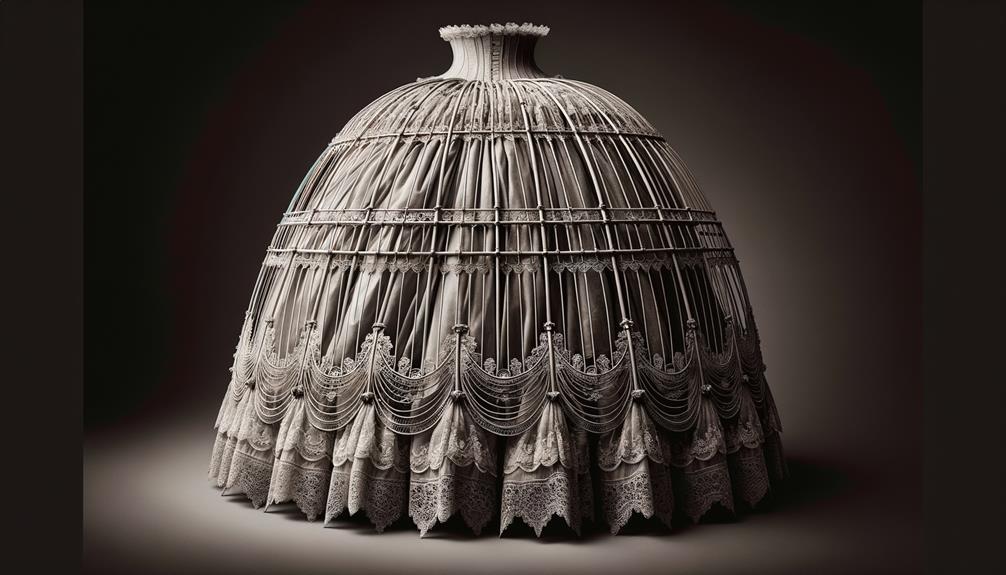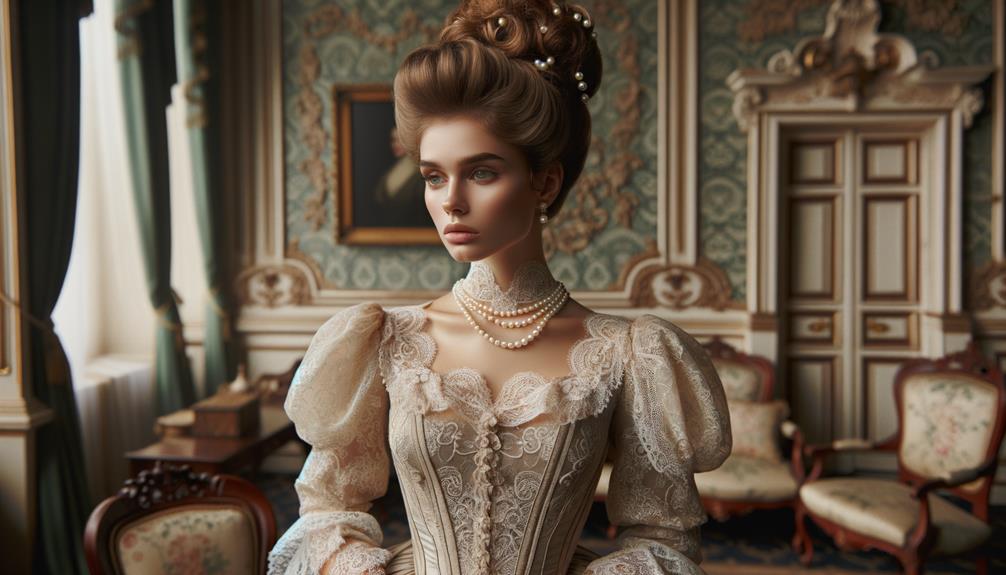The Victorian corset has long captivated our imagination, shaping the ideal silhouette of the 19th century. Crafted from hardy cotton and whalebone, it meticulously sculpted the coveted hourglass figure, a symbol of high fashion at the time. As design advancements emerged, the elaborate lacing gave way to practical hook-and-eye clasps.
But the corset was more than just a garment – it encapsulated the social constraints and tensions of the era, highlighting the complex interplay between beauty standards and women's autonomy. While early feminists viewed them as tools of oppression, today the corset continues to spark debate between fashion and health concerns. Even high fashion has reimagined this iconic garment, underscoring the layers of societal and historical implications that the Victorian corset represents.
Historical Origins
The fascination with achieving an ideal silhouette through corsetry dates back to the Minoan civilization around 1,000 BC. Even then, women sought a small waist, wearing corset-like garments to shape their figures. Fast forward to the French court in the 1500s and 1600s, where corsets gained significant popularity. Here, women used corsets to flatten their stomachs and emphasize their chests, creating a striking contrast with the voluminous full skirts of the era.
By the 1700s, corsets evolved, not just in design but in societal function. They improved posture and forced the shoulders backward, becoming ornate pieces with gold trim and silk brocades. It wasn't just fashion; it was a statement. The 1800s saw a shift towards a more natural hourglass shape, and corsets were now equipped with hook and eye clasps, moving away from the elaborate lacing.
The early 1900s brought Edwardian corsets, which shaped an S-figure, pushing the chest forward and hips back. Despite their contortions, these designs were considered healthier. Yet, the dress reform movement began to challenge the necessity and health implications of such restrictive fashion.
Structural Components
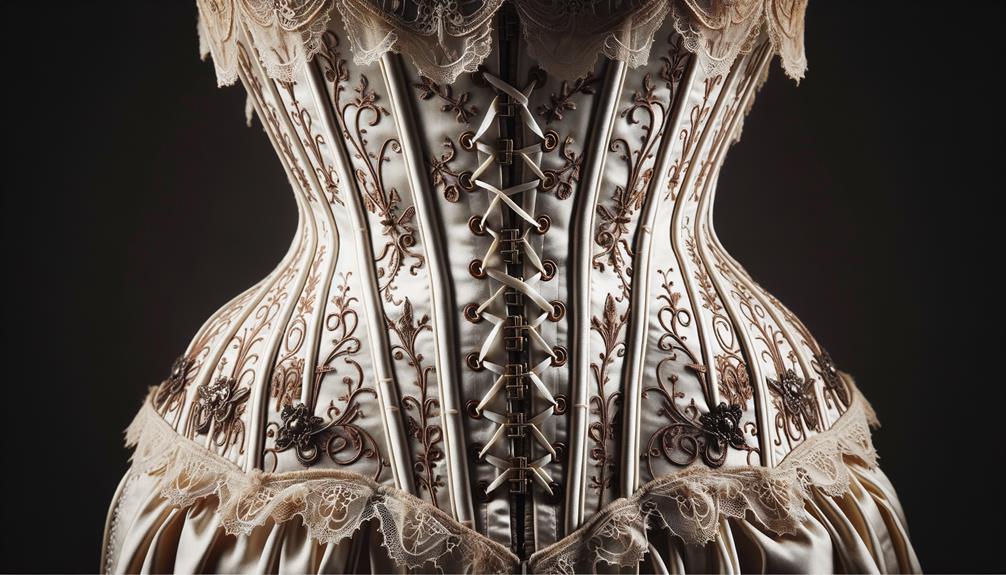
Victorian corsets were constructed with durability in mind, often using hardy cotton and incorporating a central busk made of wood or metal for support. This busk was crucial for maintaining the desired rigidity. As corsets gained popularity, shoulder straps were added to help distribute the weight, providing much-needed comfort.
A distinctive feature was the use of baleen, or whalebone, as boning, which offered both structure and flexibility. Metal eyelets along the lacing allowed for precise adjustments, ensuring the ideal hourglass silhouette. Different corset styles emerged, each serving various purposes, such as the bust improver, which enhanced the chest area.
| Component | Material | Purpose |
|---|---|---|
| Central Busk | Wood or Metal | Structural support |
| Boning | Baleen (Whalebone) | Flexibility and structure |
| Eyelets | Metal | Adjustable lacing |
| Shoulder Straps | Cotton | Weight distribution |
The meticulous construction of period corsets reveals an intersection of fashion and functionality. The choices in materials and design were deliberate, aimed at achieving an idealized silhouette. This insight into Victorian corsetry underscores how innovation in garment engineering shaped societal standards of beauty.
Fashion Evolution
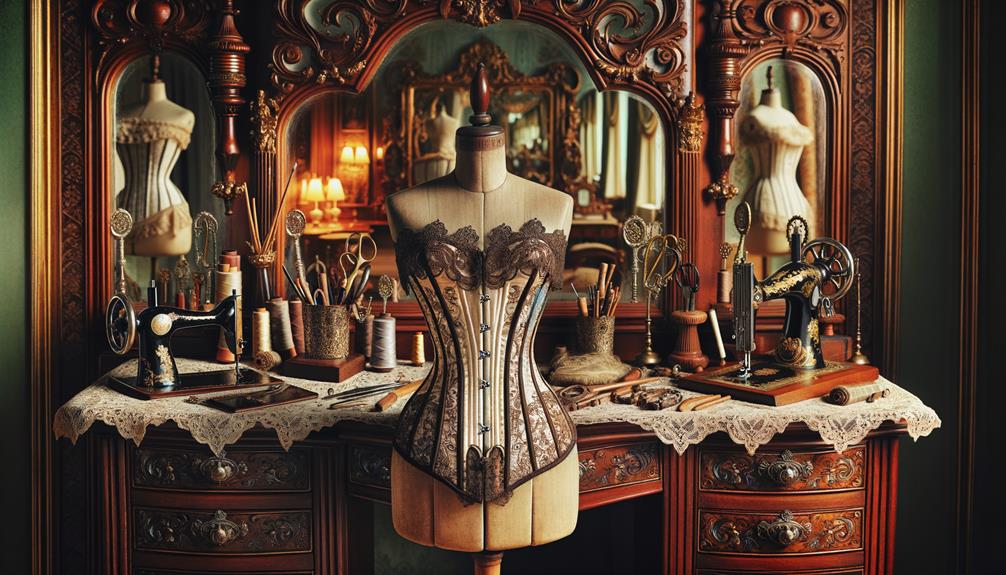
Fashion in the Victorian era went through dramatic changes, with corsets and crinolines fundamentally reshaping the ideal silhouette. This period saw the rise of the hourglass figure as the ultimate expression of femininity. Women wore corsets to cinch their waists, lift their bust, and create a smooth line from torso to hip, resulting in a strikingly exaggerated shape.
The shift from cage crinolines to steam-molded corsets in the 1850s and 1860s allowed for more voluminous and structured skirts, pushing the boundaries of dress design. These advancements became the latest fashion, enabling greater experimentation and innovation.
By the late 1860s, the crinolette emerged, emphasizing a flatter front and a more pronounced rear, altering the silhouette once again. The waistline rose to the smallest part of the torso, which, combined with front fastenings, made corsets more practical.
Advancements in sewing technology and synthetic dyes facilitated mass production. The fashion evolution during the Victorian era was marked by a continuous quest to sculpt the body into an idealized form, driven by the latest trends and technological innovations.
Social Implications
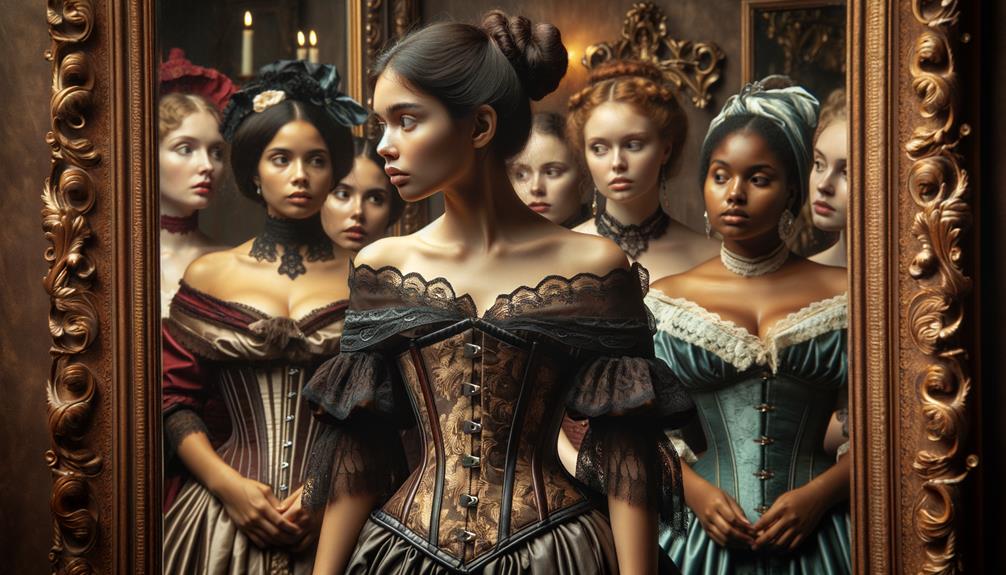
Victorian corsets weren't just about fashion; they symbolized deeper social constraints on women's autonomy. Beyond shaping the ideal silhouette, corsets became a tangible representation of the limited roles women occupied. The tight-lacing practice, often criticized, highlighted the physical toll on internal organs and fertility, reflecting the broader societal willingness to prioritize appearance over health.
As the 20th century approached, early feminists and dress reformers began to challenge these norms. They saw the corset as a patriarchal tool, physically manifesting the control over women's bodies and reinforcing traditional gender roles. This garment exemplified how women's fashion was used to keep them delicate, refined, and confined to domestic duties.
The First World War marked a pivotal shift. The war effort required women to take on roles traditionally held by men, making the restrictive corset impractical. This led to a gradual progression toward more functional attire. The silhouette without the corset became a symbol of newfound freedom and changing societal expectations.
Yet, for much of the Victorian era, corsets remained an essential component of fashionable feminine attire, underscoring the enduring tension between societal expectations and personal autonomy.
Modern Perspectives
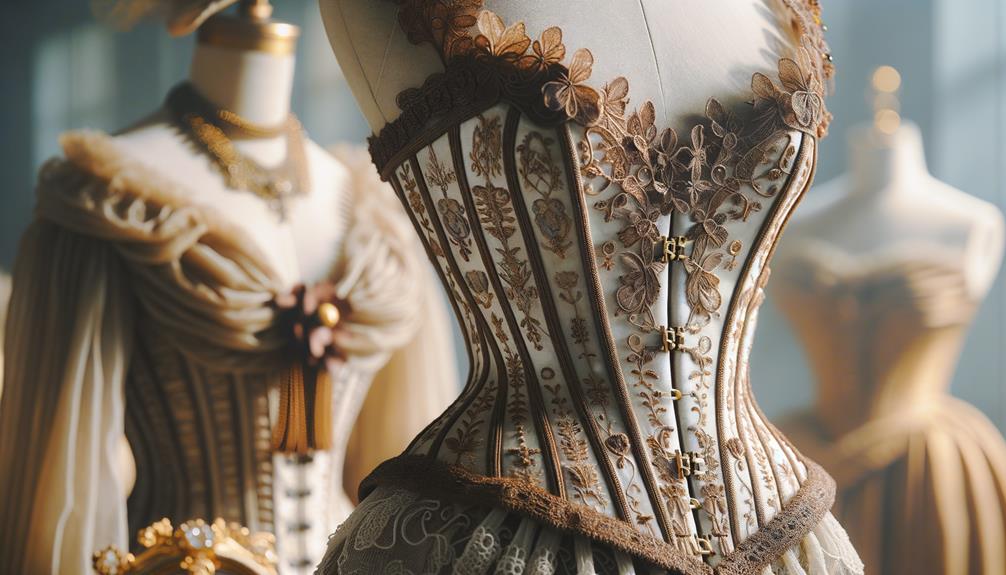
While the Victorian corset once symbolized societal constraints, today it sparks diverse interpretations and debates. Some women still embrace the corset, seeking that elusive hourglass shape. Waist training, despite its potential health risks, continues to attract adherents. The bust line is accentuated, the waist cinched, and the silhouette transformed.
From a feminist perspective, the corset is seen as a symbol of gender oppression. However, others view it as an expression of female fashion and identity, an act of empowerment. Meanwhile, health experts raise concerns about the potential risks associated with corset-wearing and waist training.
In contemporary high fashion, the corset has experienced a resurgence. Designers reimagine this historical garment, incorporating it into avant-garde collections. It's a subversion, a challenge to traditional notions of the female form. The style corset became less about restriction, more about expression.
Historians analyze the corset's significance through a modern lens, examining evolving gender norms, power dynamics, and cultural shifts. The corset is not merely fabric and boning; it's a narrative thread in the tapestry of women's history.
For some, corsets are liberating. They challenge societal expectations, asserting identity. The corset's role has shifted, yet its complexity endures.
Frequently Asked Questions
What Is the Purpose of a Victorian Corset?
The Victorian corset was designed to create an hourglass figure, improve posture, and signal moral virtue. Despite health concerns, it defined societal beauty standards of the time. As fashion evolved, the corset's role shifted, balancing aesthetics with functionality.
When Did the Bustle and Corset Shape the Silhouette?
The bustle and corset became a defining feature of women's fashion in the late 1800s. This silhouette, with its exaggerated backside and tightly cinched waist, evolved over the decades, eventually taking on an 'S-shaped' look by the 1890s. Fashion often mirrors the values and aspirations of a society, and these styles were no exception. They reflected an ideal of femininity that emphasized certain physical attributes and prescribed strict notions of how a proper lady should present herself. Of course, the trends were also propelled by ongoing innovations in textile manufacturing and garment construction. So the changing silhouette was shaped both by cultural forces and technological progress.
What Was the Corset Controversy in the Victorian Era?
The Victorian era saw a heated debate around the use of corsets. At the time, many women were tightly lacing their corsets, which led to health concerns. Reformists argued that corsets were a tool used to restrict women's autonomy and well-being, clashing with the fashion trends of the era. The controversy highlighted the tension between societal expectations and women's freedom to make choices about their own bodies.
What Was the Prominent Silhouette in the Victorian Era?
During the Victorian era, the fashionable silhouette was the hourglass shape, accentuating curves at the bust and waist with the use of corsets. This style emphasized a cinched waist and fuller upper body. By the 1890s, the silhouette evolved to a more angular, elongated form.
Conclusion
The Victorian corset was more than just a piece of clothing; it was a historical artifact that profoundly shaped bodies and societal norms. The steel and whalebone that made up the corset were tools used in the era's obsession with the 'ideal' silhouette. Today, we might view the corset as outdated or even oppressive, but it's undeniable that nothing today shapes our identity as profoundly. The corset was an extreme measure, and perhaps that's what made it so unforgettable. It's a tight squeeze into history's fabric.



